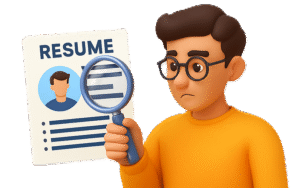What's the ideal resume length? • Should you include a photo on your resume? • What makes a resume ATS-friendly? • Do recruiters prefer summaries or objectives? • How often should you update your resume? • Are hobbies relevant to include? • What keywords boost visibility? • How to explain gaps in your resume? • Should you list every job? • Is a cover letter still necessary?
What's the ideal resume length? • Should you include a photo on your resume? • What makes a resume ATS-friendly? • Do recruiters prefer summaries or objectives? • How often should you update your resume? • Are hobbies relevant to include? • What keywords boost visibility? • How to explain gaps in your resume? • Should you list every job? • Is a cover letter still necessary?

Resume FAQs Answered
1. Why is a Resume Still the #1 Job Tool?
- It serves as your first impression to potential employers.
- It’s your personal marketing document.
- Helps you showcase your skills, achievements and qualifications.
- Acts as a screening tool for recruiters to shortlist candidates.
- It can boost your confidence and clarify your professional direction.
2. Is Your Resume Too Long or Too Short?
- Ideally 1–2 pages for most professionals.
- Recent graduates should stick to 1 page.
- Senior professionals may need 2 pages.
- Focus on quality, not quantity.
3. What Contact Info Belongs on a Resume?
- Full legal name.
- Active mobile number.
- Professional email address (avoid nicknames).
- City and state (full address optional).
- LinkedIn profile URL (optional but recommended).
4. Should You Add a Photo to Your Resume?
- In US & Canada: No, may cause bias.
- In Europe/Asia: More common – check local norms.
- Photos not needed unless applying for modeling roles.
- LinkedIn headshot is usually enough.
5. Five Quick Ways to Make Your Resume Pop?
- Use measurable achievements (with numbers).
- Customize it for each job description.
- Use strong action verbs: led, created, optimized.
- Write a compelling summary.
- Keep formatting clean and readable.
6. Red Flags That Scare Recruiters Away?
- Unexplained employment gaps.
- Copied/pasted job descriptions.
- Spelling or grammar errors.
- Inconsistent dates with LinkedIn.
- Fake credentials or degrees.
7. When Should You Update Your Resume?
- At least twice a year.
- After every new project or role change.
- Before a job search or promotion cycle.
- After certifications or training programs.
8. What is a Good Resume Summary?
- 1–3 sentences summarizing your expertise and goals.
- Tailored to the role you’re applying for.
- Highlight your biggest strengths and industry.
9. Do You Need References on Your Resume?
- No – only provide when requested.
- “References available on request” is outdated.
- Use the space for more impactful content.
10. Should You List Every Job You've Had?
- List the most relevant jobs from the last 10–15 years.
- Group freelance or contract roles if short-term.
- Summarize early roles in an “Earlier Experience” section.
11. Which Resume Format is Right for You?
- Reverse chronological is most common.
- Functional format for skill-based presentation.
- Hybrid works for career changers.
- Keep it ATS-friendly – no tables or graphics.
12. How to Handle Gaps in Your Resume?
- Be honest about breaks – use “Career Break” section if needed.
- Include skills or training done during the gap.
- Use your cover letter to explain more context.
13. How to Use Keywords for ATS Success?
- Mirror keywords from the job posting.
- Include relevant tools, certifications, and industries.
- Use acronyms and full terms (e.g., SEO & Search Engine Optimization).
- Don’t keyword stuff – stay natural.
14. Should You Use a Resume Template?
- Yes – but personalize it!
- Use a clean, ATS-friendly format.
- Ensure font, color, and layout are consistent.
- Don’t rely on Canva-style graphics.
15. Should You Mention Hobbies on Your Resume?
- Only if they show transferable skills or relevance.
- Helpful for entry-level or freshers.
- Keep it short and avoid personal/controversial topics.

